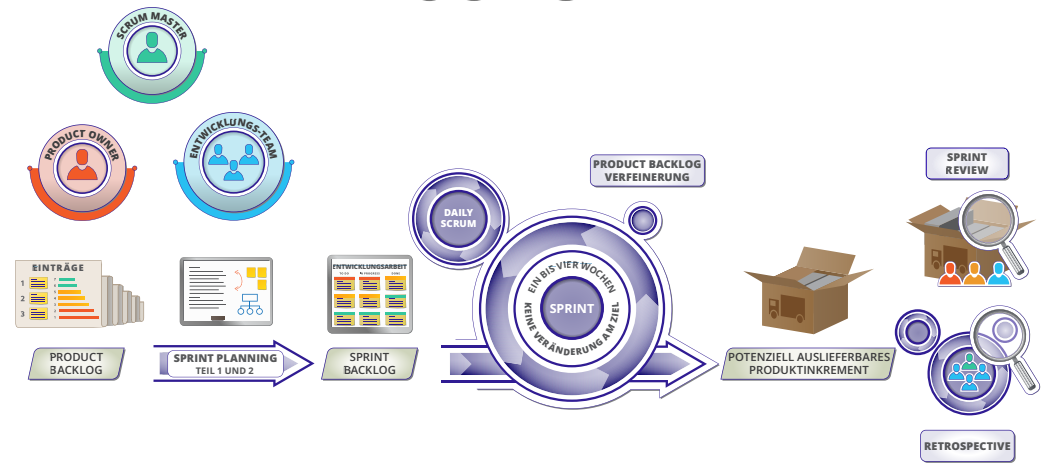-
Notifications
You must be signed in to change notification settings - Fork 17
Scrum
Maybe we can find a single were simple example within the context of VR to play througfh the whole life cycle of the Scrum process. It would also be intersting to switch roles. Maybe on a second example. Possible Subprojects to tackle within the workshop:
- Paper prototype of the Landing or Archive Page
- Wording of Emails
- Audio-FAQ
We could enforce quick descicions and speed up the example as we expierenced in the workshop we took part in at Jazoon 2013.

The main components of Scrum Framework are:
- The three roles:
- The Scrum Master
- The Scrum Product Owner
- The Scrum Team
- A prioritized Backlog containing the end user requirements
- Sprints
- Scrum Events
- Sprint Planning Meeting (WHAT-Meeting, HOW-Meeting)
- Daily Scrum Meeting
- Sprint Review Meeting
- Sprint Retrospective Meeting
-
Cross-functional
-
Self-organizing/-managing
-
Negotiates commitments with the Product Owner, one Sprint at a time
-
Has autonomy regarding how to reach commitments
-
Intensely collaborative
-
Most successful when located in one team room (particularly for the first few Sprints)
-
Most successful with long-term, full-time membership
-
7 ± 2 members
-
Has a leadership role
-
Is part of the Scrum Team
-
Facilitates the Scrum process
-
Helps resolve impediments
-
Creates an environment conducive to team self-organization
-
Captures empirical data to adjust forecasts
-
Shields the team from external interference and distractions to keep it in group flow (a.k.a. the zone)
-
Enforces timeboxes
-
Keeps Scrum artifacts visible
-
Promotes improved engineering practices
-
Has no management authority over the team (anyone with authority over the team is by definition not its Scrum Master)
-
Has a leadership role
-
Single person responsible for maximizing the return on investment (ROI) of the development effort
-
Responsible for product vision
-
Constantly re-prioritizes the Product Backlog, adjusting any longterm expectations such as release plans
-
Final arbiter of requirements questions
-
Accepts or rejects each product increment
-
Decides whether to ship
-
Decides whether to continue development
-
Considers stakeholder interests
-
May contribute as a team member
-
Has a leadership role
In Scrum there is NO Project Manager, hence the responsibilities of a project manager are distributed over the roles of the Scrum Product Owner and the Scrum Master.
The Scrum Product Owner is
- responsible for making decisions about
- functionality
- release plan
- costs
- responsible for the content and the planning
The Scrum Master is
- responsible for tracking the tasks within a Sprint
- responsible for resolving impediments
Pivotal Jargon: Icebox
As an [actor], I [want|must] [action] so that [achievement]
Or in a shorter version:
As an [actor], I [want|must] [achievement]
-
When: At the beginning of each Sprint
-
Who: the Product Owner and team
-
The Product Owner is responsible for prioritization
-
The Team is responsible for commitment (avoiding technical debt)
-
Backlog Refinement Meeting (Estimations)
- technical debt leads to eventual design death
- http://www.scrumprimer.org/ (English, German)
- http://www.scrum-institute.org/What_Is_Scrum.php
- http://scrumreferencecard.com/ScrumReferenceCard.pdf (6 Pages, English)
- http://scrummasterchecklist.org/pdf/ScrumMaster_Checklist_12_unbranded.pdf (4 Pages, English)